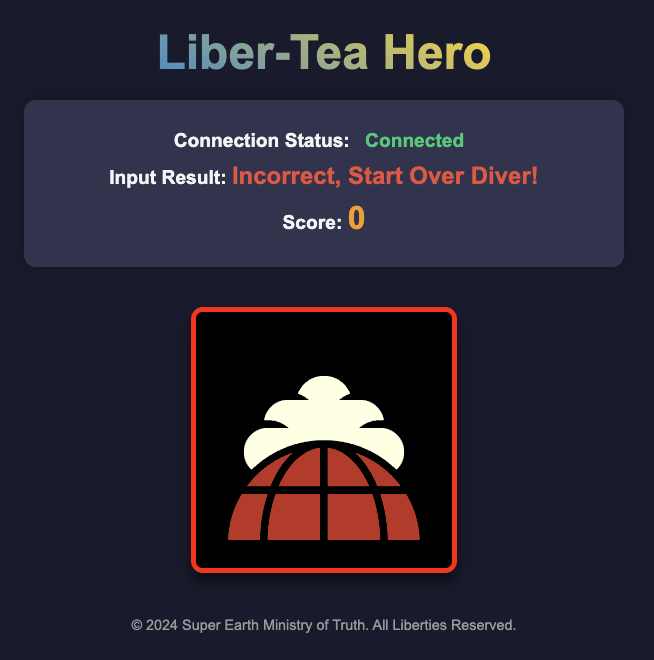Hey there diver! You haven’t completed your annual strategem training yet! You want to be mince meat for the enemies of managed democracy? I didn’t think so. Hop to it, or I’ll be speaking with your Democracy Officer!
The URL leads to a website with content similar to the screenshot below. Pressing WASD or the arrow keys displays that an input is either correct or incorrect.

A Discord message notes that we need a score of 250 to get the flag.
Viewing the page source, we find the logic that controls the input result in controls.js. The code sends a message to a WebSocket with a time limit. We can guess that we should input the correct sequence of key presses in order to pass the “current level”. We also guess that each image displayed corresponds to a fixed sequence of key presses.
We can easily send requests to a WebSocket through the Javascript console, so we will write a script to quickly brute force every image given.
In order to answer queries quickly, we keep an object d (for dictionary) with the key presses needed for each image.
let d = {
// ...
"data:image/webp;base64,UklGRpwDAABXRUJQVlA4TJADAAAv/8A/APfBKJIkRVV9zOf2fN+XxgbbSJKc3Mz/oyEB8jcJCZMYtGAUSZKirtrdY7Jz/i3dD+c/iGwjAAUqAsMfDQAAGlUpzukQZaD8QSz1rNKvtxP1TLfj3qgCAFFRfdURCAQCIwBRAkFUmyv2qv077d8M36zmyz5t2lz1VadJxTosoppUCAQBAEGU4F4O2QqeuNaTgqK17W3bBiITxu52mr0026JtdqJSWbj/+4IJavz80a3/+7+I/k9AOPv/7P8zHD9/mUjqxSbzfKk4Fa4X+DQ4NOtT4NCty+fQrkvn0K/L5tCwS+bQscvl0LJL5dCzy+TQtEvkUPDdAkR5HIV39fLpdgGiNI7C25/0Ql4VIMriKORn6sXMrgrgkjgKaWaqsTsFcDkchXdMPcYCuBSOQpqCjAVwGRyFNBUZC+ASOAppSrI7BfDTcxTeMTUZC0SlKcooEU1VRnloyrI70twxdRlloSnMKAlNZUY5aEqzO1LcMbXt9fMQbSSHaMeoOhuy0UP2v26+ffR7RcwAZC1JLBd9AsCFhZbk/vJv7ttvtdC0WbfeMRWT3h3m2itGV19LdvMt0p634IGuvYq/au7e4n06+Nun9w4E3MSNH/f3eQw1sVy8SkdsXB4CwHf72//UPXvXpxPkOz/A94pyMp30FvP9/KCjBy+ZhCQf6Kpl55vXSdzXdG+poz/6JDZdR0n0vy/I+P/WQvFQKB4Kxf8tJ+c/t0LxUCgeCsVn/539908zds0sm3nHIXozy2becYjezLKZd5ycKBu6tsmcXSp0NpmzS4XOJnN2aWoihOu7NqP3JfQ2o/cl9Daj91MTIR1W161S8eq6VSpeXbdKExMhHy4zSyMtszTSMksTEzEFfcYxzDiGGScmYhLwMMDTaA/wNNoDPE1LxEQgIO0xIO0xIE1LxGQ8xz6eYx/PMS0R0yGiRBGVF1F5EUr7WowIkedbubYcgBQOqSkVQ6EQDsFfSOSh+LMIEbL30jDoeyELg8YvN3JsLaj81oX1MmztwnWWP5HAgvLfnJqHCtyeUh/qcH4y/SJU44vTeB5qstsdXx/qsvX17rj6RajMpmX3/Jieh0p9dyxvQ70++3AMu6ehZi9/Oty6C1V76+Lyw2F2Xcu6yefb/b17Fip5vi8PFd3v4+dQ14t+zMevUFnAL2VPQ41374fMQ5W37paZO+ts1rB7nEBvm1mdnf1/9v//uQc=": [
"down",
"left",
"down",
"down",
"up",
"left"
],
// ...
};To construct this d by brute forcing images, we’ll first find the first direction at index i = 0 by brute forcing each direction directions[di] for di = 0 to 3, then find the second direction at index i = 1, and so on. We’ll store the correct directions we’ve accumulated in a list l.
Let’s first define these variables and a couple of constants.
const directions = ['left', 'up', 'right', 'down'];
const t = 10; // Timeout used to avoid race conditions
let l = [];
let i = 0;
let di = 0;
let guess = true; // Indicates if a new guess should be made. Used to avoid race conditions
let con = true; // Used to stop the brute forceWhen we run the following bruteforce function, which sends the next direction(s) to try, we send the list of directions recorded in d if it exists. Otherwise, we send all the currently recorded directions l[i], then try new directions directions[di].
function bruteforce() {
// Setting con = false in the console allows us to stop the brute force at any time
if (con) {
if (cur in d) {
l = null;
guess = false;
for (const x of d[cur]) {
sendMessage(x);
}
return;
}
if (i < l.length) {
sendMessage(l[i]);
} else {
sendMessage(directions[di]);
}
}
}When we receive a message, we’ll want to call this bruteforce function again to send the next guess. If the message is incorrect, then we need to resend the recorded sequence of correct directions (i.e. reset i = 0), then guess the next possible direction (i.e. increment di).
if (typeof message.data === "string" && message.data.trim() === 'false') {
// ...
i = 0;
di = (di + 1) % directions.length;
if (l !== null) {
bruteforce();
}
}If the message is correct, we can add directions[di] to our accumulated list l, increment i, and reset di = 0.
else if (typeof message.data === "string" && message.data.trim() === 'true') {
// ...
if (guess) {
if (i >= l.length) {
l.push(directions[di]);
di = 0;
}
i += 1;
if (l !== null) {
bruteforce();
}
}
}If a new image appears, we’ll add l to our dictionary, reset our variables, wait a little bit to avoid any possible race conditions from other requests, then run bruteforce on the next image.
else if (typeof message.data === "object") {
const imgElement = document.getElementById('dynamic-image');
const base64img = await convertBlobToBase64(message.data);
imgElement.src = 'data:image/webp;base64,' + base64img;
if (!(cur in d)) {
d[cur] = [...l];
}
cur = imgElement.src;
l = null;
i = 0;
di = 0;
setTimeout(() => {
l = [];
bruteforce();
}, t);
}And that’s it! Modifying console.js to include these bits of code and copying and pasting it into the console runs our brute force at a speed fast enough to get the flag within a few minutes or so.
Flag: TUCTF{4_S00p3r_3aRtH_3xP3rT}
The final solve script can be found here. We pre-fill d with entries gathered (copied and pasted) from previous runs to make the code run faster.
I recommend checking out other writeups, such as this Discord message by fr0j, for scripts written in other languages (e.g. Python 3). Join the TUCTF Discord for access.
d